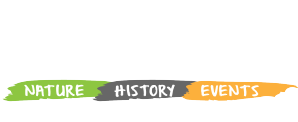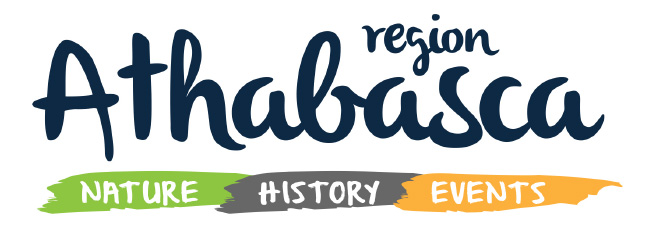Photo: Grand Rapids Wilderness Adventures
Getting Wild
The Athabasca region is uniquely situated on the Alberta Boreal forest’s lower edge and bisected by the Athabasca River. There are many areas that boast untouched forests, pristine lakes, abundant wildlife and other natural features that offer travellers a taste of the Alberta wilderness.
Just an hour and a half north of Edmonton and 4.5 hours from Calgary, the Athabasca region makes for an easy wilderness getaway for all skill levels. Let’s take a look at some of the possibilities…
Grand Rapids Wilderness Adventures
 One of the premiere wilderness experiences in the Athabasca region is heading down the Athabasca River by jet boat to the Grand Rapids Wilderness Adventures lodge. Your hosts, Darcy and Shirley Zelman will show you the rarely visited natural and historic sites on this stretch of the Athabasca River.
One of the premiere wilderness experiences in the Athabasca region is heading down the Athabasca River by jet boat to the Grand Rapids Wilderness Adventures lodge. Your hosts, Darcy and Shirley Zelman will show you the rarely visited natural and historic sites on this stretch of the Athabasca River.
You’ll meet up in the town of Athabasca and travel for approximately 5 hours downriver, stopping to check out multiple sites. The first stop is an area with real old-growth forests where some of the trees are hundreds of years old and so big you can’t wrap your arms around them.
Next, you’ll stop to check out an abandoned Hudson’s Bay trading post. There are a lot of relics left behind displaying the history of the Athabasca River being an important transportation route in early Canada.
Don’t be surprised if there are stops to view the Boreal species that inhabit the area like wolves, bears, moose, deer and raptors to name a few, as the river valley has abundant and varied wildlife.
Your hosts will set you up in a cozy cabin and provide delicious meals to keep you energized for your adventure. You’ll be kept busy with opportunities to fish on the river or paddle around in a canoe.
 One of the best features of this trip is the Grand Rapids themselves. A unique geological occurrence created these rapids:
One of the best features of this trip is the Grand Rapids themselves. A unique geological occurrence created these rapids:
The rapids are a result of river erosion of the 110-million-year-old sandstone of the Grand Rapids Formation. This formation, which forms the large, nearly vertical outcrop on the east side of the valley, is divided into three major sandstone layers. The lowermost level creates the rapids because it is filled with large, two-to-three-metre wide concretions that often contain pieces of petrified logs. These concretions were formed in a similar fashion to those at Red Rock Coulee. As the river erodes away the sand matrix, these huge concretions come loose and dam the river bed. – A Traveller’s Guide to Geological Wonders in Alberta by Ron Mussieux and Marilyn Nelson
GRWA offers a variety of packages. Be sure to book early, as this exclusive adventure fills up quickly.
Check out the videos produced by “Let’s Go Outdoors” on their experience with Grand Rapids Wilderness Adventures:
Episode 1: https://youtu.be/eSDvmqSC2go
Episode 2: https://youtu.be/K491X3ih0lo
Episode 3: https://youtu.be/KnT5X1DdZaI
Grand Rapids Wilderness Adventures Online:
www.athabasca-river.com
www.facebook.com/Athabasca.River
The La Biche River Wildland
 Just to the northeast of the town of Athabasca lies the La Biche River Wildland. This pristine natural area is only accessible through Poachers Landing.
Just to the northeast of the town of Athabasca lies the La Biche River Wildland. This pristine natural area is only accessible through Poachers Landing.
There are over 17,000 hectares of undisturbed Boreal forest:
La Biche River Wildland Park protects an undisturbed native boreal forest landscape that consists of wetlands and dense forests of poplar, aspen, spruce, birch and fir. The area provides habitat for black bears, lynxes, wolverines, woodland caribou, moose and beaver. – Alberta Parks
There are no formal campgrounds here, other than at Poachers Landing, but backcountry camping is allowed all year long. Other activities include OHV use (please stay on trails to protect this sensitive area), horseback riding, hiking, boating, snowshoeing and more. Special permits are required for fishing, hunting, guiding and other activities.
The Poacher’s Landing campground has 6 unserviced sites and is a first come, first served campsite. There is a boat launch into the Athabasca River, a cookhouse and restrooms. It opens on May 20 and closes on September 20.
https://albertaparks.ca/parks/north/la-biche-river-wpp/information-facilities/
The Peace River Wilderness Trail
 Part of the Trans Canada Trail includes the Peace River Wilderness trail that runs from just north of Athabasca to northeast of Smith, AB. This route was first used by the Indigenous peoples of the area. With the advance of colonial traders, settlers and the gold rush, Euro-Canadian explorers used this trail as a route north.
Part of the Trans Canada Trail includes the Peace River Wilderness trail that runs from just north of Athabasca to northeast of Smith, AB. This route was first used by the Indigenous peoples of the area. With the advance of colonial traders, settlers and the gold rush, Euro-Canadian explorers used this trail as a route north.
Spectacular wilderness area with interesting native flora and fauna and views of the Athabasca River. Moose, elk, deer, wolves, black bears and most boreal mammals are abundant. Bald eagles and other raptors make their permanent home in this area. The trail itself was part of one of the principal routes attempted by gold seekers headed to the Klondike in 1898-99 and was a primary settlement path followed by pioneering farming families to the Peace River country until approximately 1920 when it was superseded by the railway. Remnant historical sites located along the trail include gravesites and the Tomato Creek stopping house (developed by the Goodwins in 1910), portrayed in the movie, “Silence of the North.” – http://www.albertatrailnet.com/
The trail follows the Athabasca River through some old-growth Boreal forest. Expect wildlife like bears, wolves, moose, deer, and other Boreal species. It is approximately 60 km from trailhead to trailhead. Permitted uses include hiking, cross-country skiing, bicycles, horses, snowmobiles, and all-terrain vehicles.
The southern trailhead is approximately 30 km north of the Town of Athabasca. There is some parking at each trailhead, and there are three unserviced campsites along the route. Please pack out all garbage and stay on the marked trail. Be bear smart when storing food.
White Earth Valley Natural Area
 If back-country camping isn’t your speed, the White Earth Natural Area provides a Boreal wilderness experience with the comfort of a campground nearby in Long Lake Provincial Park. It is located about 110 km north of Edmonton on Highway 831, which is accessible from Highway 63 North. It’s about 20 km south of the village of Boyle, where you can stock up on supplies.
If back-country camping isn’t your speed, the White Earth Natural Area provides a Boreal wilderness experience with the comfort of a campground nearby in Long Lake Provincial Park. It is located about 110 km north of Edmonton on Highway 831, which is accessible from Highway 63 North. It’s about 20 km south of the village of Boyle, where you can stock up on supplies.
The White Earth Trail is 17 km long. The path winds through a wide variety of rich habitats, where an abundance of diverse plants and wildlife thrive. It’s accessible from adjacent Long Lake Provincial Park during operating season (May to October), with parking at the trailhead. The trail can also be accessed year-round from Township Road 621 at the southern end of the Natural Area. – Alberta Parks
The White Earth Valley NA is adjacent to thousands of hectares of undisturbed Boreal forest which promotes great habitat for many Boreal species, including bears and wolves. Use caution around wildlife and be bear-smart with food storage.
https://www.albertaparks.ca/parks/north/white-earth-valley-na/
Hubert Lake Wildland Provincial Park
The Hubert Lake Wildland Provincial Park is about an hour southwest of Athabasca and about 2 hours northwest of Edmonton. The Hubert Lake WPP offers kilometres of trails through a central mixed-wood boreal landscape. The Athabasca River is on the west border and the Pembina River is on the east.
Hubert Lake Wildland Park consists of a sand dune complex and numerous small lakes and wetlands. Jack pine is the dominant tree species on the dunes. Itervening depressions support black spruce and larch, with open fens in wetter areas. The park is an important nesting area for great blue herons and sandhill cranes. A small caribou herd wanders in and out of the park.
Backcountry camping is allowed, with two unofficial sites on the map. OHVs are permitted on designated trails only. Off-trail use is prohibited.
Learn more here: https://www.albertaparks.ca/parks/north/hubert-lake-wpp/
Otter-Orloff Lakes Wildland Provincial Park
The Otter-Orloff Lakes Wildland Provincial Park is about an hour north of Athabasca, 2.5 hours north of Edmonton and 3 hours southwest of Fort McMurray.
The “road” to Orloff Lake only goes a portion of the way. In dry weather, this road is good but dead ends near Rock Island Forestry Tower. When the road is wet, it can be very slick and muddy. The remaining trail into Orloff Lake is approximately 4 km, accessible by ATV or foot only. This trail can be in very poor condition when wet. In dry conditions, it is a fair trail at best (lots of mud holes and trail braiding). Only the last 400 meters of this trail is within the park. There has been no trail maintenance.
Wetlands and forests in this park support a variety of wildlife. Lakes contain walleye, pike, perch and lake whitefish and are important habitat for beaver, muskrat and waterfowl. Orloff Lake has a great blue heron colony. Younger forests in the park contain white spruce and aspen. Mature forests contain birch and balsam poplar. White spruce and balsam fir dominate old growth stands. Black spruce and larch occur in wet areas.
Random backcountry camping is allowed. Learn more about permitted activities here: https://www.albertaparks.ca/parks/north/otter-orloff-lakes-wpp/
If you have questions about wilderness experiences in the Athabasca region or anything else Athabasca Region Tourism-related contact us here.

